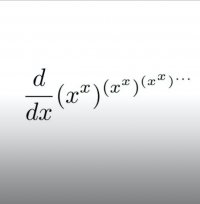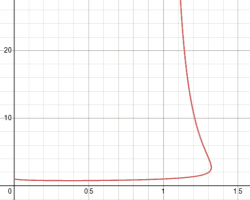You are using an out of date browser. It may not display this or other websites correctly.
You should upgrade or use an alternative browser.
You should upgrade or use an alternative browser.
Derivative of infinite x^x
- Thread starter Luciferr
- Start date
D
Deleted member 4993
Guest
Steven G
Elite Member
- Joined
- Dec 30, 2014
- Messages
- 14,603
Cubist
Senior Member
- Joined
- Oct 29, 2019
- Messages
- 1,699
I agree, but @Subhotosh Khan had a great idea there, and this must be the necessary adjustment... [imath]y=(x^x)^y[/imath]
Steven G
Elite Member
- Joined
- Dec 30, 2014
- Messages
- 14,603
Thanks. I didn't see the adjustment [imath]y=(x^x)^y[/imath]. I need to have my vision checked.I agree, but @Subhotosh Khan had a great idea there, and this must be the necessary adjustment... [imath]y=(x^x)^y[/imath]
topsquark
Senior Member
- Joined
- Aug 27, 2012
- Messages
- 2,363
To the corner with you, you scurvy swine! (I could use someone to play rock paper scissors with.)Thanks. I didn't see the adjustment [imath]y=(x^x)^y[/imath]. I need to have my vision checked.
-Dan
Steven G
Elite Member
- Joined
- Dec 30, 2014
- Messages
- 14,603
Why are you in the corner? What did you do this time around?To the corner with you, you scurvy swine! (I could use someone to play rock paper scissors with.)
-Dan
topsquark
Senior Member
- Joined
- Aug 27, 2012
- Messages
- 2,363
I advised someone to use the Lambert W function where it couldn't actually be applied.Why are you in the corner? What did you do this time around?
I'm a baaaad boy.
-Dan
Steven G
Elite Member
- Joined
- Dec 30, 2014
- Messages
- 14,603
Sloppy, very sloppy.I advised someone to use the Lambert W function where it couldn't actually be applied.
I'm a baaaad boy.
-Dan
D
Deleted member 4993
Guest
Blasphemy!!!!What did you do this time
He invoked Lambert without any basis.......
topsquark
Senior Member
- Joined
- Aug 27, 2012
- Messages
- 2,363
Help! I'm being lambasted about Lambert!Blasphemy!!!!
He invoked Lambert without any basis.......
-Dan
Steven G
Elite Member
- Joined
- Dec 30, 2014
- Messages
- 14,603
What do you need help with? What have you tried? Did you read the posting guideline?Help! I'm being lambasted about Lambert!
-Dan
Please start a new thread!
Cubist
Senior Member
- Joined
- Oct 29, 2019
- Messages
- 1,699
Steven G
Elite Member
- Joined
- Dec 30, 2014
- Messages
- 14,603
Thanks for this graph. Now this is initially surprising. Can you show a graph of the derivative?Here's the graph of [imath]y=(x^x)^y[/imath]
View attachment 32807
The graph starts near, or on, (0, 1) depending on how you view 0^0. It goes through (1,1) and then appears to double back where y=e. Then there's a vertical asymptote at x=1.
And there should be a point at (-1, -1)
BeachBanana
Senior Member
- Joined
- Nov 19, 2021
- Messages
- 2,281
I used Desmos and it gave me something different for [imath]y=(x^x)^y[/imath]Here's the graph of [imath]y=(x^x)^y[/imath]
View attachment 32807
The graph starts near, or on, (0, 1) depending on how you view 0^0. It goes through (1,1) and then appears to double back where y=e. Then there's a vertical asymptote at x=1.
And there should be a point at (-1, -1)
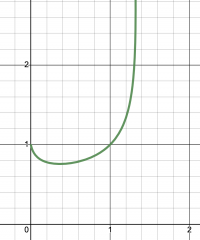
This is what I got for the derivative.
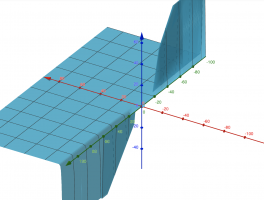
Cubist
Senior Member
- Joined
- Oct 29, 2019
- Messages
- 1,699
I used Desmos too, but I zoomed out the y axis scale to see how it folds back for higher y values!I used Desmos and it gave me something different for [imath]y=(x^x)^y[/imath]
View attachment 32809
This is what I got for the derivative.
View attachment 32810
Example x = 1.3 implies y ≈ 4.22484229404955304071 or y ≈ 1.93426050277962582024
Cubist
Senior Member
- Joined
- Oct 29, 2019
- Messages
- 1,699
Here's a graph of the gradient (red and green curves) with the original shown in blue. Note that the graph is cut at the thick black line. Beneath that line the y axis is on a different scale, since the gradient is very steep and negative. The x axis values are aligned in both sections of the graph.
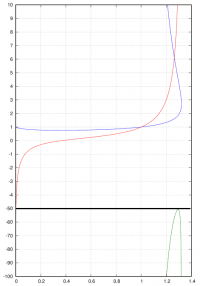
Note: The gradient is exactly 1 at (1, 1)
EDIT: This only shows the gradient at the (x,y) points where the equation [imath]y=(x^x)^y[/imath] is true, even though the expression I obtained for the gradient gives a field of values (and this is probably what is shown in post#15)

Note: The gradient is exactly 1 at (1, 1)
EDIT: This only shows the gradient at the (x,y) points where the equation [imath]y=(x^x)^y[/imath] is true, even though the expression I obtained for the gradient gives a field of values (and this is probably what is shown in post#15)
Last edited:

